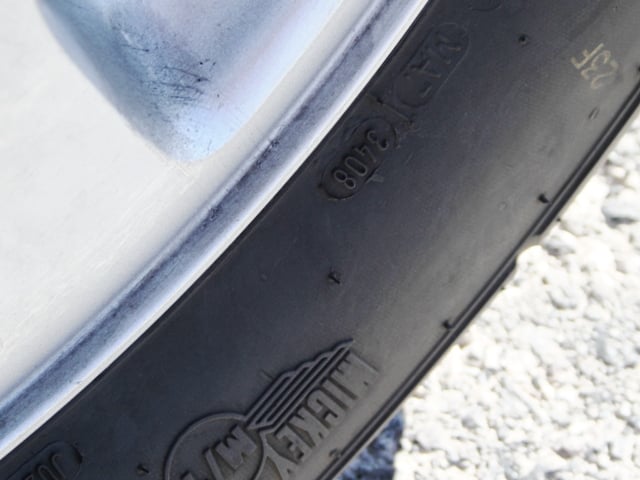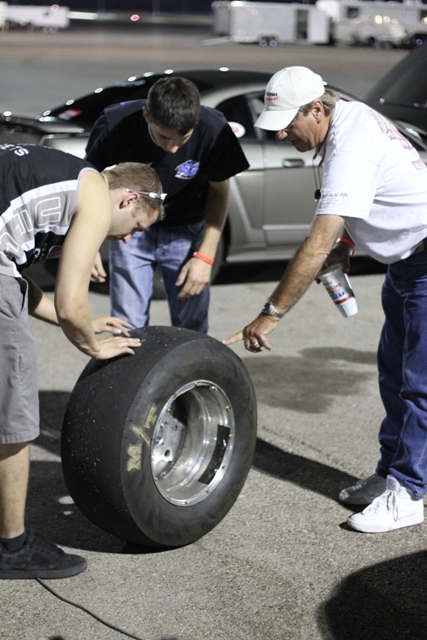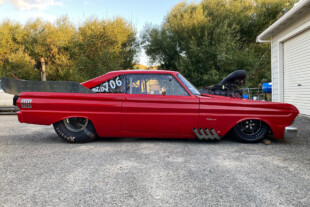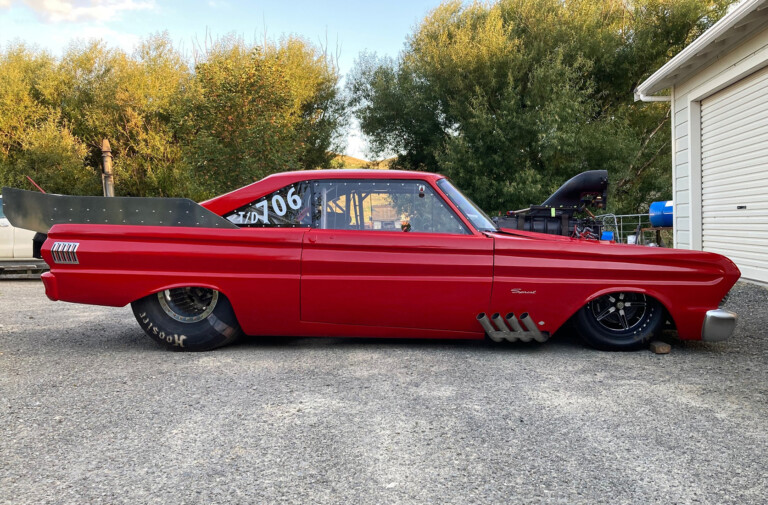 A racer’s tires are literally where the rubber meets the road – it doesn’t matter how much power you’re making or how quick you are on the tree if you can’t keep those two small patches of rubber in intimate contact with the track. But to some, they’re a mystery; you’ll hear someone say that their slicks just “went off” or that they just can’t get their new whiz-bang drag radials to hook up at a particular track. What those guys don’t know is that there is a lot of information written across the tread face and sidewalls of their tires, and to teach us how to read it, we turned to Mickey Thompson Tires Motorsports Manager Carl Robinson.
A racer’s tires are literally where the rubber meets the road – it doesn’t matter how much power you’re making or how quick you are on the tree if you can’t keep those two small patches of rubber in intimate contact with the track. But to some, they’re a mystery; you’ll hear someone say that their slicks just “went off” or that they just can’t get their new whiz-bang drag radials to hook up at a particular track. What those guys don’t know is that there is a lot of information written across the tread face and sidewalls of their tires, and to teach us how to read it, we turned to Mickey Thompson Tires Motorsports Manager Carl Robinson.
Like anything else in the non-sparkly-vampire universe, tires aren’t immortal, and freshness is important. The first step in reading your tires is, well, actually reading them – or at least what’s encoded on the sidewall. “The tire can give a pretty good account of its life and health in several ways,” Robinson explains. “One of the first things I recommend is to identify the manufacturing date found in the serial code on the tire. Generally it’s the last four digits and represents the week and year of manufacture. Knowing the date is not the only key, but it establishes the lifeline of the product.” There’s no hard and fast rule about when a tire is too old, but more recently-manufactured tires are less likely to have UV or ozone damage from careless storage. If the tires have been previously mounted, Robinson suggests, “A visual inspection of the bead area is strongly recommended to insure there has been no damage due to mounting, movement of the tire on the wheel, or improperly installed wheels screws.”
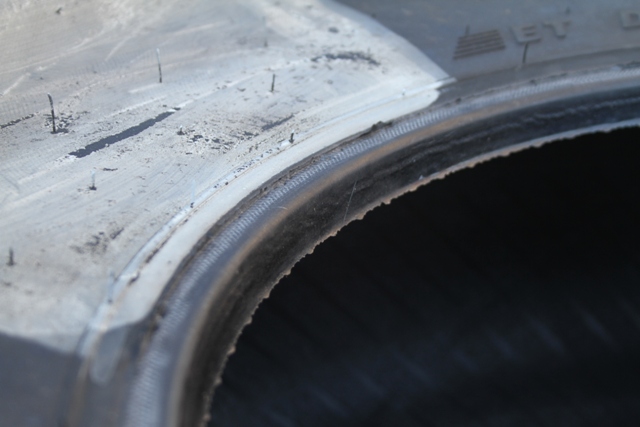
Before mounting, inspect the bead area for damage, especially on tires that have been previously used.
Once you’ve determined that there’s nothing obviously wrong with the bead, it’s time to get to the meat of the tire. “The tread can be a strong indicator,” says Robinson. “Inspect the entire tread looking for any cuts or potential punctures. Older tires tend to be “dryer” on the tread than those that are new. This is not to suggest the tire’s condition is unfavorable, but it can be a factor if the tires were stored improperly.”
Room to Grow
With new bias-ply slicks, a little record-keeping from the very start can pay dividends down the line. Most racers know that they’ll increase in diameter down track; per Robinson, “Most often your tires will grow from 5/8 to over an inch, and different combinations will yield varying growth.” What you may not know is that the initial, brand-new “rollout” (circumference) of a bias-ply tire at rest will change once you start to use it. “Typically the tire will be “set” after 3 to 5 runs,” Robinson explains, at which point it shouldn’t change diameter from there on out. “A thorough history of the tire’s circumference measurement should be documented. The size of your tires, especially bias ply tires, is critical to the entire combination as the roll out and growth of the tire establishes the final drive ratio. In most cases each inch of roll-out can change finish line RPM by about 125 RPM.” Drag radials, on the other hand, don’t change diameter unless there’s something seriously wrong. Per Robinson, “Radial race tires are not generally affected with this trait. Because of the construction, radial tires are almost always identical in size and do not grow during the run as do the bias-constructed race tires.”
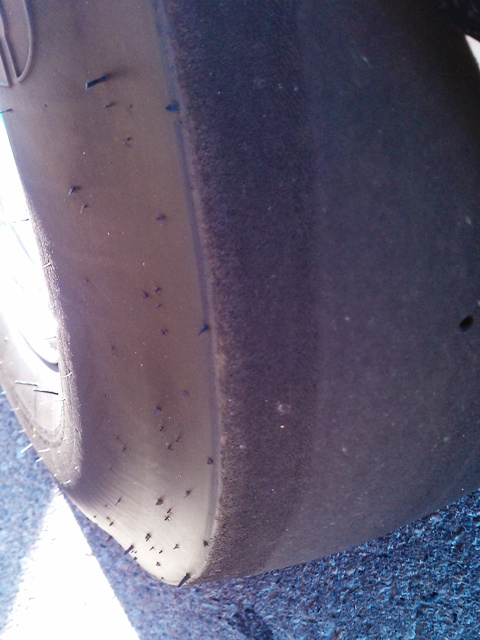
Tire size doesn't just affect gearing; growth at high RPM or suspension squat on the launch can lead to contact with the fenderwells, as evidenced here.
Smoke ‘em if you got em…
Inspection of your tires can also give you clues about inflation pressure and burnout technique. In the same way you can read a spark plug’s temperature by looking at the color of the ground strap, indications left on the margins of a slick can tell you a lot. “A close inspection of the tread and shoulder area can offer clues to determining the correct duration of your burnout,” says Robinson. “If tires are worked hard in the water box, there will be evidence on the shoulder’s edge.”
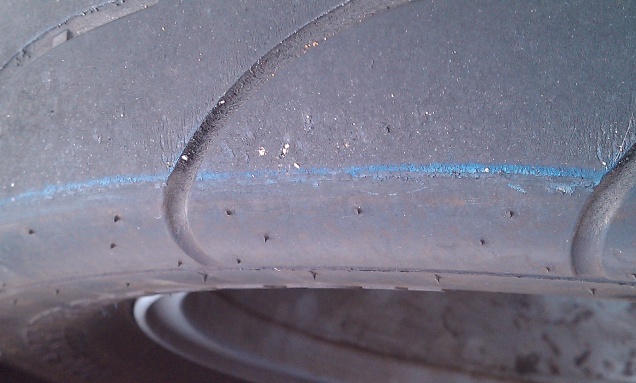
Tires that are worked too hard in the burnout box will often develop a blue border on the edges of the tread.
As far as setting the correct tire pressure is concerned, the first place to look is obvious signs of wear in the center (overinflation) or edges (underinflation) of the tread face. Going lower doesn’t always improve grip, and too little pressure can lead to “cupping” that lifts the center of the tread face away from the track surface. The type of tire also plays a role in finding the ideal PSI. Per Robinson, generally speaking, “Radials require greater air pressure to perform optimally when compared to bias-ply tires, and most of the benefit in performance comes from reduced rolling resistance.” Going too low gives up that advantage in the quest for sidewall flex that’s just not going to happen with a stiffer radial carcass. Robinson concludes, “I’m sure it’s possible to get close to your ideal tire pressure by visual inspection but I believe that that time slip is the ultimate guide. Always consider the ambient conditions and try to develop an understanding as to how they affect your combination. Good data is very important.”

Underinflation has led to "cupping" on this tire, shown by the V-shaped pattern on the tread surface.
One of the more obvious things a close inspection of your tire tread can tell you is how much tread thickness actually remains, by examining the wear indicators. Once again, though, it’s part of the puzzle, not the whole picture. Sometimes a tire will start to ‘go away’ before the tread is done, but according to Robinson, “Not in every case. We have had many customers bring their tires to our M/T Service trailer with the cords showing. They always brag about how well the tires worked right down to the cords!”
As they say in the commercials, ‘your mileage may vary.’ Robinson admits, “Honestly, there are so many different combinations at the drag strip that to attempt to predict the life of a drag tire on any particular car is a real gamble. Too many factors weigh in. Also, there are other components besides the tread that can affect performance. Heavy cars with big power can reduce the resilience of the tire reducing its spring rate, for example.” So how do you know when it’s time to say goodbye to a pair of slicks? “Ultimately it’s the measured performance that will tell the truth on your tires,” says Robinson. “Look hard at the incremental times provided on the time slip. Check the performance of your fellow racers. Track conditions and ambient temperature also weigh heavily in the consistent performance of your car.”

Tread depth isn't a surefire guide to how well a drag tire will work, but keeping an eye on the indicators can give you insight into how the tire is wearing across the treadface.
Side to Side
One way of making sure that you’re getting your money’s worth out of a pair of drag slicks is to rotate them from side to side to even out the wear. Once again, an examination of the tires will provide clues to when it’s time. Robinson advises, “Watching your 60-foot times closely, along with a visual inspection of the tread are your best indicators. Some applications will never see a benefit from rotation, while others will. If you notice the tread of your tires “feathering” (a unique texture that’s much easier to show than describe) this could be indicating tire spin or slippage. Rotation can extend the effective life of a tire, as some cars can establish wear patterns that reduce the contact patch.” Drag radials, on the contrary, are often unidirectional and shouldn’t be rotated, though it is possible to remount them on the opposite rims if uneven wear across the tread face occurs in an IRS application.
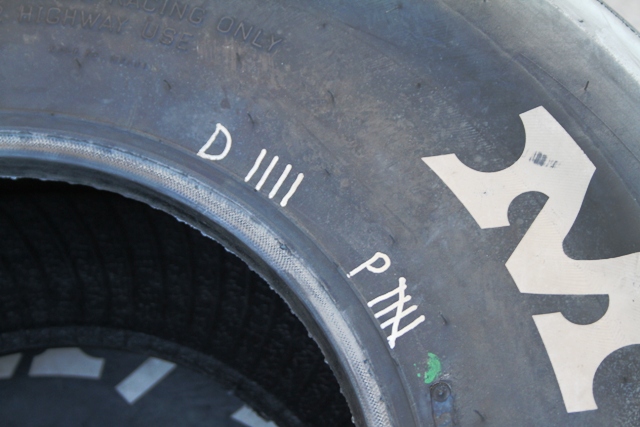
Rotating tires from side to side can add to their useful life, even in very high horsepower applications.
Speaking of bias-ply vs. radial, when we asked Robinson on whether there’s a difference between what you’d look for, he offered the following advice: “The radial tire has a different shape in the shoulder area. Bias-ply tires tend to be square at the edge, and the radial is rounded. This makes “reading” the radial a little more challenging. There is no distinct edge. I’ll go back to the good old time slip – it tells you what the car wants!” In that same vein, Robinson has a bit of guidance when it comes to choosing between the two in the first place. “When shopping for a DOT tire, most customers have an option to go bias or radial,” he explains. “Since the majority of those with street-based performance cars utilize automatic transmissions, the radials become an ideal choice for most in the DOT applications. Most ‘street based’ clutch cars lack the high end adjustability required to benefit from a radial. If you run a clutch, then stick to the bias-ply ET Street tire.”

Drag radials are a little bit different to read compared to slicks thanks to their rounded shoulder contour.
Street to Strip
We’ve spoken in general terms throughout this article, but there are clearly differences in how a tire works on an 11-second bracket car, compared to an Outlaw 10.5 racer. The question obviously arises as to how much they have in common when it comes to understanding what your tire is telling you. Robinson explains, “Well, the 11-second bracket car should be a dead-hook program, but that’s another topic! Really it comes down to understanding the conditions and the time slip. What you want ideally is consistency and efficiency. If you see your 60-foot times going up and down, then look to the track conditions and draw comparisons to your competition. If your 60-foot times go up consistently, then your tires may have lost their ability to hold your car or create enough grip.”



